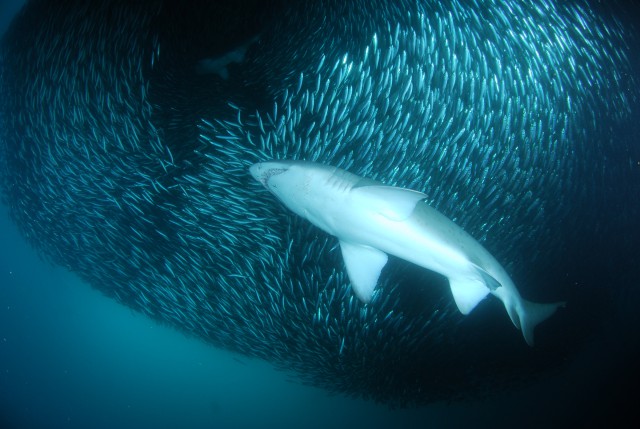“The bait ball sits about 12 metres below the surface of the water. A 50-100 metre biomass. Hundreds of thousands of sardines. We make it possible for people to sit above it or dive right into the action. For seven or eight hours we follow it down the coastline, getting in and out of the water as the action kicks off.
Often the first indicator of where the action’s happening is spotting the gannets. At times, you have whole colonies of gannets diving from above. These birds spend up to six months out at sea, feeding on bait balls like this. They are incredible aerial predators.
With them you get common dolphins in their thousands. Or, if two pods have joined up, you can get up to 15,000, all attacking the ball. We sometimes switch off the boat’s motor and sit there for a hour surrounded by dolphins. They’re as far as the eye can see.
For us, the most exciting spectacle is seeing a Bryde’s whale come, mouth wide open, and lunge through the sardines, taking every fish with it. It’s a mind-blowing experience.”
Unsurprisingly, Rob and Debbie consider this to be the greatest phenomena of its kind in the world. And they should know: Rob’s been a professional diver for his entire career. For Debbie, the call came a little later. What was a weekend hobby became her passion. An offer of a job teaching diving in Mosambique saw her leave a well-paid career in 1996. She’s not looked back.
“Anyone growing up here is entwined with the ocean in one way or another. It becomes part of your life, whether that’s to make a living or just to feel connected to the Earth. So the Sardine Run is something we’ve always known. As children, we would explore up and down the beach and in rock pools. Then came surfing. Then boats. Each step opens up a new way to explore the ocean. Keeps you coming back to discover more.
We consider the ocean to be the final frontier. Every time you dive, you don’t know what you’re going to see. In fact, you could live 100 lifetimes and still not have seen all the marine life there is to see. That’s the addictive aspect of it. And what we wanted to capture by making diving here accessible to others.”
Thanks to years building an almost encyclopedic knowledge of the dive sites along this stretch of coast, Rob and Debbie have played guide to the world’s most prolific natural history advocates - including National Geographic and the BBC’s Natural History Unit. But what is it about the Wild Coast that makes it such a Mecca for marine life?
“The Sardine Run is a spectacle that happens every day way out in the ocean, too deep for us to access. The unique positioning of the Wild Coast means that it comes right up to our shores once a year, during the winter migration.
We have a perfect storm, geographically speaking. During the winter, cold fronts coming in from the Atlantic and Antartica meet the warm Indian Ocean in the east. A tongue of colder water gets pulled from the Atlantic and pushed up the east coast of South Africa. It’s the ideal habitat for sardine, which then travel up the coast with it. What makes us unique is being on the Agulhas Bank, part of a continental shelf that makes the water relatively shallow offshore here.”
“Come with no expectations”, warns Debbie. They are as much at the hands of Mother Nature here as anywhere else. However, they always have a trick or two up their sleeves.
“There are dive sites around here where razor-tooth sharks hang out - and where we’ve never seen anyone else. We’re fairly sure we’re the only people who know about them.
Even more incredibly, at the same time as the Sardine Run, our location means we’re also privileged to witness the annual migration of humpback whales incredibly close to shore. Some days you just see one or two around you. Others 30 or 40 will pass the boat.
You’re guaranteed to see something phenomenal every day you’re here. We just don’t know what it will be until it happens.”
